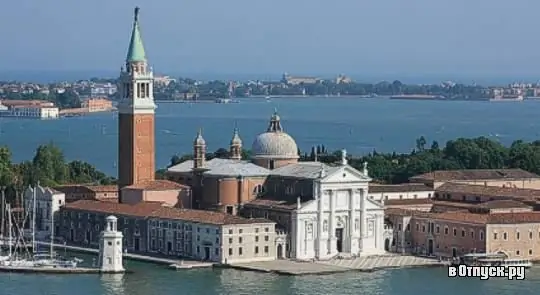
Description of the attraction
San Giorgio Maggiore is a 16th century Benedictine church located on the island of the same name in Venice. It was designed by the great architect Andrea Palladio and built between 1566 and 1610. The church has the status of a basilica and is made in the classic Renaissance style. Its gleaming white marble façade is reflected in the blue waters of the lagoon opposite the Piazzetta and serves as the centerpiece of the Riva degli Schiavoni promenade.
The first church on the island of San Giorgio Maggiore was built around 790, and in 982 the entire island became the property of the Benedictine order, who founded a monastery here. Unfortunately, in 1223, all buildings on the island were destroyed by an earthquake. Later, the church and the monastery were rebuilt. A church with a central nave and side chapels was erected a little to the side from the previous place. In front of it was the cloister, which was demolished in 1516.
In 1560, the famous Andrea Palladio arrived in Venice. In that year, the monastery refectory was under reconstruction, and the famous architect took part in the construction. And five years later he was asked to work on a new church project. Palladio completed his project by 1566, and in the same year the foundation stone was laid in the foundation of the temple, and the church building itself was actually completed in 1575. Only the choir behind the altar and the façade remained unfinished. The choir was built between 1580 and 1589, and work on the façade continued until the early 17th century. In 1791, the bell tower was rebuilt, originally erected three centuries earlier. Today, a wonderful view of Venice opens up from its top.
The famous façade of San Giorgio Maggiore shines with white. Designed by Andrea Palladio, it is an excellent solution to the problem of combining the classical temple façade with the essence of the Christian church, with its high central nave and low side chapels, which has always been a challenge for architects. Palladio actually combined two facades: one with a wide pediment and architrave stretching over the entire nave and both aisles, and the other with a narrower pediment and giant columns on high pedestals. On both sides of the central portal there are statues of Saints George and Stephen, to whom the church is dedicated.
The interior decoration of the church with massive columns and pilasters on white walls is striking in its scope. On either side of the presbytery you can see paintings by Tintoretto - "The Last Supper" and "Heavenly Manna". The Benedictines retained control over the chapels of San Giorgio Maggiore for a long time and did not sell them to aristocratic families, as was done in other Venetian churches. But later the tradition took its toll. The chapel to the right of the altar belonged to the Bollani family, and for some time remained without decorations. Only in 1708, paintings by Sebastiano Ricci appeared in it.






